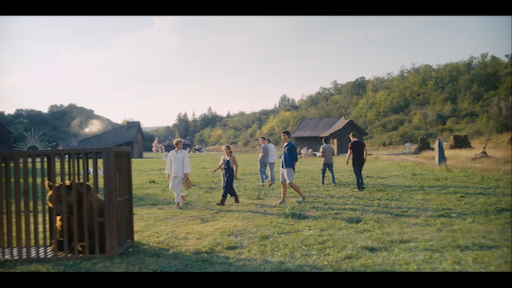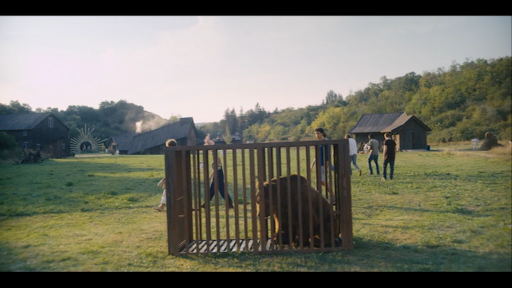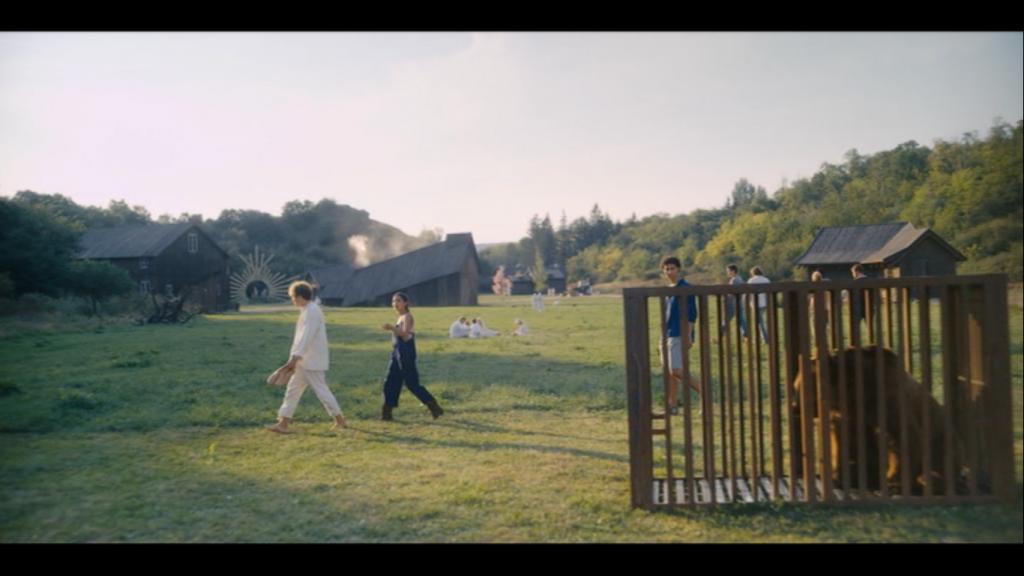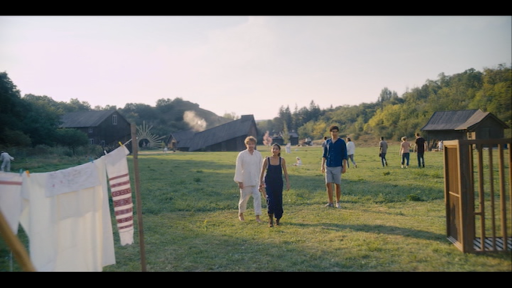– ‘So are we just going to ignore the bear then?’
– ‘It’s a bear.’

Fig. 1 
Fig. 2

Fig. 3 
Fig. 4
This sequence focalises through the eyes of the newcomers in unfamiliar territory and instills a sense of foreboding and uncomfortable mystery into the film through the conspicuous image of a caged bear. The questions brought about by the bear’s filmic presence feed into the overarching feelings of disorientation and tension in Midsommar. Aster creates a strange incongruence between the audience and the film, but there is also a simultaneous blurring of the boundaries of character and audience, with the alignment of a shared fixation on the creature’s presence. The tracking shot of Connie (Ellora Torchia), Simon (Archie Madekwe) and Ingemar (Hampus Hallberg) is interrupted by the bear in the foreground, which is a noticeably darker hue than the rest of the light and airy mise-en-scene and makes a stark visual contrast to its surroundings. Coupled with its central place in the shot composition, it obscures the characters as they walk behind it, meaning the audience has no choice but to pay attention to it. The audience uses this short verbal exchange and our awareness of cinema conventions to understand that Aster would not have placed this animal in such a conspicuous area of the shot composition, had it had no meaning:
Simon: So are we just going to ignore the bear then?
Ingemar: It’s a bear.
Meta-conceptions are created when Ingemar pointedly overlooks its presence, where we feel unsure as to why we have very clearly been made to look at this animal that has been briefly acknowledged and then disregarded in the context of the film. Aster plants the bear into the narrative in the form of a ‘Chekov’s gun’ – a dramatic component formulated by Pavel Chekov stating that all elements introduced into a story must be necessary. Narrative components are there to serve a purpose and so, implicitly, audiences are conscious that the self-awareness with which Ingemar dismisses the bear tells us that obviously, its true meaning, suggested being ominous, is yet to be revealed. Like Simon, who is seen to return to gazing at the caged bear unlike the other characters who walk away from it, our eyes and minds linger on the creature, wondering what role it is yet to serve.
The fact that the bear is also caged, rather than roaming free in the landscape further suggests that it must serve a greater unknown purpose; the cult has clearly captured the bear for a reason. It has been brought to Hårga by human agency, rather than animal, meaning that there must be a yet undisclosed human requirement for it. Its cage also foregrounds implicit ideas of entrapment and inescapability; visually, the cage obscuring Connie and Simon places them within its confines – the inescapable sacrifices awaiting them in Hårga. The bear becomes symbolic of the growing mystery and uncomfortable tone that is seeping into the film; though there is minimal interaction between the characters and the bear within the film’s universe at this point, its proximity to the camera suggests that Aster has instead placed the bear there for the audience. Its persistence to be noticed alludes to its true fatal role in the narrative; it warns of the price paid for ignorance and uninformed dismissal.